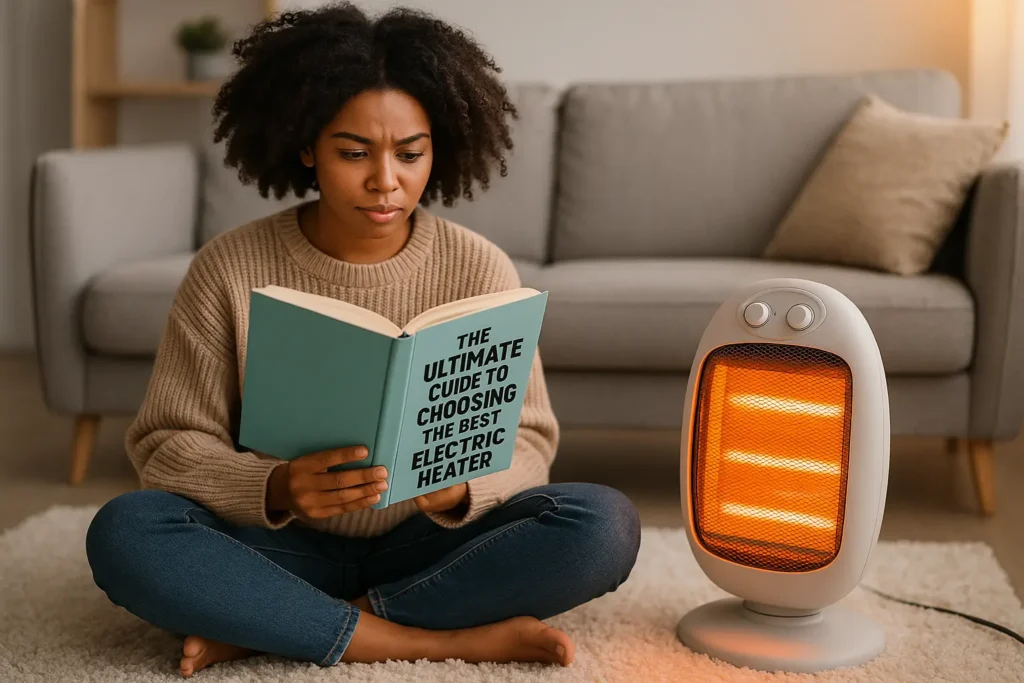Whether you’re steeling yourself for a chilly Australian winter night or looking for a tiny electric heater for your bedroom, selecting the right model can make all the difference in keeping toasty and warm while staying on budget and safe. As you consider the best electric heaters for home use, check out our guide to help you discover which style might work best in a variety of spaces, and to learn more about what features to look for.
Benefits of Using an Electric Heater
There’s a reason why modern electric heaters have such pride of place in Australian homes. Roll them in for a shot of immediate heat that will ameliorate the morning chill, and their portability means they can be wheeled or carried to the place of maximum use. The variety of types is truly impressive: you’ll find sleek ceramic heaters that heat rapidly, dependable oil heaters for warmth that stay with you throughout the day and into the night, and smart options featuring benefits like Wi‑Fi control, programmable thermostats, and timers to help keep energy use in line.
A lot of choices are also made with eco‑friendly technology or can even be hooked up to renewable energy sources, so you can feel great about reducing your footprint while keeping warm. For small-scale heating, such as in a bedroom or office, selecting the best electric heater can make all the difference between a comfortably heated space and a freezing work area.
Energy-Efficient Electric Heaters for Homes
Energy efficiency is the key to that balancing act between warmth and less money spent, and not all heaters deliver on this point equally. Ceramic heaters heat up quickly and are ideal for targeted spots, while oil heaters take their time to warm up but also stay warm for a long time after they’re turned off, making them great for larger spaces.
Fan heaters, meanwhile, are light and inexpensive, perfect for occasional gusts of heat (though they can be noisy), while convection heaters provide a slow but steady and silent blast of warmth that fills an entire room. Radiant heaters, meanwhile, offer direct and immediate warmth to you rather than heating an entire room that’s filled with space.
Among the best of what’s on offer (the De’Longhi HCM2030 convection heater is a budget‑friendly favourite according to reputable Australian reviews, such as ExpertEasy’s 2025 roundup, and the Dyson Pure Hot+Cool fan heater does double duty as an air purifier in one for year‑round service.
| Heater Type | Best For | Pros | Cons |
|---|---|---|---|
| Ceramic Heater | Quick, targeted heating | Fast warm‑up, compact | Limited range |
| Oil Heater | Long‑lasting warmth | Retains heat, quiet | Slower to heat |
| Fan Heater | Spot heating | Lightweight, affordable | Can be noisy |
| Convection Heater | Even room heating | Silent, steady warmth | Slower to heat |
| Radiant Heater | Direct warmth | Instant heat, energy‑efficient for small areas | Limited coverage |
Cost of Running an Electric Heater
Operating costs will depend on a heater’s wattage, how much you are charged for electricity, and how many hours you operate it. For instance, a 1,500‑watt heater consumes approximately 1.5 kWh/hour. At a hypothetical average Australian price of 30c/kWh, that’s around 45c per hour or about $108 if used eight hours a day.
The good news is, with some modern heaters complete with the likes of thermostats, eco‑modes, or even smart plugs, you can bring that cost down. If you’re looking for something a little easier on the hip pocket, type in cheap electric heater Australia and many perfectly decent options will be under $100 – good choices for use now and then or in smaller rooms as extra heating.
Electric Heater With Thermostat
An electric heater with a thermostat removes the guesswork from achieving a cozy home by letting you set — and maintain — your ideal temperature. Rather than repeatedly switching the unit on and off, the integrated thermostat automatically adjusts to maintain your desired temperature setting, making it easier for you to warm up those icy-cold spots in a chilly room — without worrying about over-cooking or wasting energy. It’s a great option for bedrooms, offices, or any room that needs a little extra shot of warmth and offers the ease and convenience, as well as cost‑effectiveness, all in one.
Safety Tips for Operating Electric Heaters
Australian safety regulations are among the world’s most stringent, making it worthwhile to invest in a compliant heater. Find built‑in tip‑over shut‑off, overheat protection, and cool‑touch surfaces that are safe for children and pets. Plug your heater directly into the wall, not an extension cord, and keep it three metres away from anything that can burn, such as curtains or furniture. Features such as an accurate thermostat help prevent overheating, and a stable base limits the risk of tipping over.
How to Install an Electric Heater
Setting up a space heater is easy – unbox, plug it in, and adjust to your desired settings. Wall‑mounted heaters are an excellent choice when space is at a premium and generally have instructions for mounting that are easy to follow. Still, sometimes it is better to pay a professional to make your house as safe as you can. Baseboard heaters (they’re wired directly into your home’s electrical system) do usually demand an electrician, but in return provide a constant, low‑profile heat that blends right into your space.
Maintenance Tips for Electric Heaters
It doesn’t require much effort to keep your electric heater in good shape, but providing regular attention will reward you with a better-performing appliance. Dust and lint can clog venting and reduce efficiency, so it’s worth vacuuming vents or replacing —or at least cleaning — filters as appropriate. Inspect the power cord and plug for damage, and verify that safety features such as the tip‑over switch and thermostat are working. Store your heater in a clean, dry place once the winter season has passed to help avoid moisture and damage.
Troubleshooting Common Electric Heater Problems
If your heater’s on the fritz, first things first: Check the outlet, cord, and fuse box even — or should we say especially — if you barely creased open that user’s manual before tossing it aside. Not enough heat? That can indicate you need to adjust your settings, or it might mean the unit is too small for the room. Weird rattles or buzzes typically indicate loose bolts or wiring that requires tightening. If your heater shuts off, it could be overheating due to blocked vents, which is a problem you can solve with a quick clean.
Winter Heating Solutions for Australian Homes
Pair an energy-efficient electric heater with a few simple home insulation steps, and it can make all the difference for your comfort, as well as your utility bill. Sticker draft stoppers on doors, closing the curtains at night, and layering up in clothing can all help you depend less on your heater — ultimately saving money and energy.
Frequently Asked Question
It depends on the room size and how you plan to use it. For quick bursts of warmth, a fan or radiant heater works well. For steady heat in larger rooms, consider an oil or convection heater.
Running costs vary by wattage, usage time, and electricity rates in your area. Choosing an energy‑efficient electric heater and using the thermostat can help keep bills manageable.
Yes. A built‑in thermostat automatically maintains your chosen temperature, saving energy and preventing overheating — especially handy for bedrooms or home offices.
If the heater has safety features like tip‑over protection, overheat shut‑off, and meets Australian safety standards, it can be used for extended periods. Always follow the manufacturer’s guidelines.
Oil‑filled and convection heaters are good choices as they have lower surface temperatures. Look for models with child‑lock features and strong stability to prevent tipping.
Use it in well‑insulated rooms, keep doors closed, and only heat the space you’re using. Pairing it with a thermostat or timer can also reduce wasted energy.
Final Thought
It’s all about knowing your space, how you heat, and your budget when it comes to finding the best electric heater Australia has. Whether it’s a portable heater to warm up the study, a ceramic unit to quickly heat small spaces, or oil heating through the night that keeps you cosy all through winter, making the right selection will mean comfort without any nasty surprises when your power bill arrives. And with smart, safe, energy‑efficient options available today, you don’t have to choose between cosiness and efficiency.

